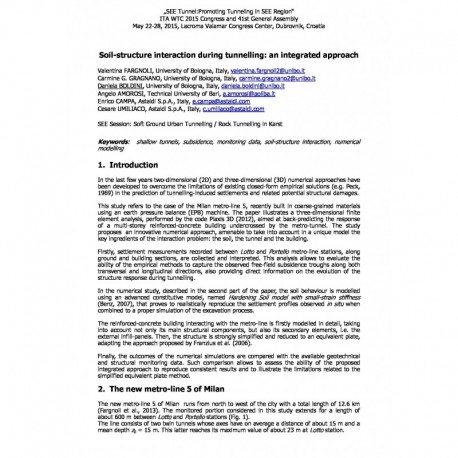Cart
0
0
No document
0,00 €
Total
Document successfully added to your shopping cart
Quantity
Total
There are 0 items in your cart.
There is 1 item in your cart.
Total documents
Total shipping
To be determined
Total
Search & filter
Search for a publication
Search & filter
Viewed documents

Soil-structure interaction during tunnelling: an integrated approach
wtc2015_full_fargnoli
V. Fargnoli / C. G. Gragnano / D. Boldini / A. Amorosi / E. Campa / C. Umiliaco
In the last few years two-dimensional (2D) and three-dimensional (3D) numerical approaches have been developed to overcome the limitations of existing closed-form empirical solutions (e.g. Peck, 1969) in the prediction of tunnelling-induced settlements and related potential structural damages. This study refers to the case of the Milan metro-line 5, recently built in coarse-grained materials using an earth pressure balance (EPB) machine. The paper illustrates a three-dimensional finite element analysis, performed by the code Plaxis 3D (2012), aimed at back-predicting the response of a multi-storey reinforced-concrete building undercrossed by the metro-tunnel. The study proposes an innovative numerical approach, amenable to take into account in a unique model the key ingredients of the interaction problem: the soil, the tunnel and the building. Firstly, settlement measurements recorded between Lotto and Portello metro-line stations, along ground and building sections, are collected and interpreted. This analysis allows to evaluate the ability of the empirical methods to capture the observed free-field subsidence troughs along both transversal and longitudinal directions, also providing direct information on the evolution of the structure response during tunnelling. In the numerical study, described in the second part of the paper, the soil behaviour is modelled using an advanced constitutive model, named Hardening Soil model with small-strain stiffness (Benz, 2007), that proves to realistically reproduce the settlement profiles observed in situ when combined to a proper simulation of the excavation process. The reinforced-concrete building interacting with the metro-line is firstly modelled in detail, taking into account not only its main structural components, but also its secondary elements, i.e. the external infill-panels. Then, the structure is strongly simplified and reduced to an equivalent plate, adapting the approach proposed by Franzius et al. (2006). Finally, the outcomes of the numerical simulations are compared with the available geotechnical and structural monitoring data. Such comparison allows to assess the ability of the proposed integrated approach to reproduce consistent results and to illustrate the limitations related to the simplified equivalent plate method.


